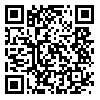BibTeX | RIS | EndNote | Medlars | ProCite | Reference Manager | RefWorks
Send citation to:
URL: http://jdisabilstud.org/article-1-2294-en.html
2- Associate Professor, Departement of Psychology, Roudehen Branch, Islamic Azad University, Roudehen, Iran
3- Assistant Professor Departement of Psychology, Roudehen Branch, Islamic Azad University, Roudehen, Iran
Background & Objectives: The family is a natural social system in which men and women are the main subsystems in all stages of its development and many factors, such as communication patterns, identity styles, and resilience play a role in their marital satisfaction. One of the concepts that guarantee the stableness and stability of a couple's life is marital satisfaction. Moreover, communication patterns are one of the necessary areas for marital satisfaction. Communication patterns are more the results of experiences of family interactions than of a personality trait. In addition to couples' communication patterns, another variable affecting marital satisfaction is the identity styles of spouses. One of the variables that can affect marital satisfaction as well as communication patterns and identity styles is spouse resilience. Since marital satisfaction has an important role in the stability of marital life and numerous factors are effective in marital satisfaction of couples, it is important to study them. This study aimed to determine the effect of communication patterns and identity styles on marital satisfaction mediated by resilience.
Methods: In the present descriptive correlational study, the statistical population included married men and women referring to counseling centers and psychological services in Tehran in 2020. Of these, 302 eligible individuals entered the study. Participants were 158 women and 144 men. Totally, 9 participants were in the age range of 18–28 years, 126 in the age range of 29–39 years, 137 in the age range of 40–50 years, 22 in the age range of 51–61 years, 6 in the age range of 62–72, and 2 were in the age range of 73 years and above. The criteria for subjects to enter the research were informed consent to answer the questions, at least education in high school, at least one year has passed since the marital status of the sample, and no history of divorce. Also, not answering 25% of the research questions was the criterion for the subjects to leave the research. The instruments used included the ENRICH Marital Satisfaction Scale (Fowers & Olson, 1993), Communication Patterns Questionnaire (Christensen & Sullaway, 1984), Identity Styles Inventory (ISI3) (Berzonsky, 1992), and Connor–Davidson Resilience Scale (Connor & Davidson, 2003). Descriptive statistics methods (frequency, percentage, mean and standard deviation), Structural equation modeling, and the Pearson correlation coefficient were used for data analysis in SPSS, and AMOS software were used to analyze the data, with the significance level at 0.05.
Results: The results showed that the total effect of information identity style (p=0.001, β=0.497), inefficient communication pattern (p=0.009, β=–0.062) and constructive communication pattern (p=0.001, β=0.584) was significant on marital satisfaction. Constructive communication pattern (p=0.008, β=0.215), and information identity style (p=0.001, β=0.371) had an indirect effect on marital satisfaction through resilience. Also, inefficient communication pattern through resilience had an indirect effect on marital satisfaction (p=0.001, β=–0.334). The hypothesized model fit the collected data (AGFI=0.971, RMSEA=0.033).
Conclusion: Based on the findings of the current study, constructive and inefficient communication patterns and information identity style have effects on marital satisfaction through resilience.
| Rights and permissions | |
 |
This work is licensed under a Creative Commons Attribution-NonCommercial 4.0 International License. |



